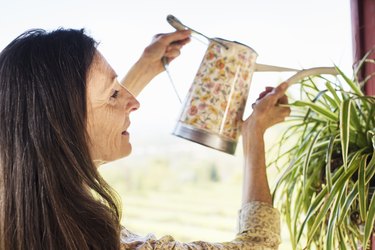How to Add Moisture to the Air Without a Humidifier

Houseplants, especially spider plants, can increase humidity in a room without a humidifier.
Image Credit: Mint Images/Mint Images RF/GettyImages
Dry air in your home can cause various issues, including nosebleeds, cracked lips, an uncomfortable night's sleep and even trouble breathing, according to the Mayo Clinic. Unfortunately, these annoyances pop up even more in the dry winter months.
While a humidifier will increase the moisture content of your home or room, it may also increase your electric bill (depending on the type and size), and it can actually promote mold if the moisture isn't kept in the ideal 30 to 50 percent range, according to the Environmental Protection Agency (EPA).
Here, Clayton T. Cowl, MD, a pulmonologist with the Mayo Clinic, shares how humidity in the home can affect your health and offers some tips on how to humidify a room naturally without using a humidifier.
Tip
"Many strategies for increasing the overall humidity within a living area have been utilized for years, probably by your parents," Dr. Cowl says. "Cooking on the stove, boiling water, letting bathtub water cool before draining it and keeping a bathroom door open when showering have all been traditional ways of attempting to increase humidity."
1. Put Your Tub or Shower Water to Work
Evaporation is when water changes from a liquid to a gas, where it adds moisture to the air, according to the U.S. Geological Survey (USGS). So you'll want to start with a place in your house that sees a lot of water: The bathroom.
After bathing, leave the water in the tub and let it cool instead of immediately draining it. This allows time for the moisture to evaporate into the air.
Similarly, after taking a hot shower, open the bathroom door to allow the steam to naturally humidify nearby rooms.
2. Get More Plants
Sure, they make a room look pretty, but a houseplant can also add moisture to the air via the process of transpiration. Once a plant is watered, moisture will travel through the roots up to the leaves, according to the USGS. From there, it's released through pores in the leaves, increasing the humidity level in the room.
Any type of plant will do, but spider plants and jade plants are among the best for increasing indoor humidity, according to a December 2016 paper in HortTechnology, a journal from the American Society for Horticultural Science.
3. Turn Vents or Radiators into Humidifiers
You can utilize the very source of that warm, dry heat to add a little moisture to a room and create a kind of makeshift humidifier.
Place a pot or bowl of water near your heat source — either on a radiator or near a vent. As it heats up, the water will evaporate into the air, increasing moisture.
4. Decorate With Vases or Fountains
Go for the tranquil look! Fill some vases with colored stones or marbles and some water, and set them on sunny windowsills. Or relax with a running fountain in the room.
By adding more water to your space, you're encouraging evaporation to occur, and voilà — you have a natural alternative to a humidifier.
5. Air-Dry Your Laundry
Instead of drying your clothes and towels via machine, allow them to air-dry by hanging them on a drying rack or over the backs of chairs. The damp clothes will release water back into the air as they dry.
Bonus: In addition to humidifying your home, this method will also save you money on your electric bill.
6. Boil Water on the Stove
This is a simple one: Throw a pot of water on the stove and boil away! The hot steam will help humidify the room naturally.
7. Use the Dishwasher
Your time-saving dishwasher is also another great humidifier alternative.
Here's what to do: Steam-dry your dishes and, as soon as the cycle is complete, open the door to get a blast of moisture.
Humidity Levels and Your Health
The level of moisture in your room shouldn't be too high or too low. "Humidity is a balance — lack of humidity can result in drying of the upper airway, which is a known respiratory irritant," Dr. Cowl says. What's more, your system isn't as effective at removing dust, irritants or invaders like viruses and bacteria, he adds.
But you know what they say about too much of a good thing.
"Too much humidity in an indoor environment may create a sense of 'heaviness' of ambient air that is more difficult to inhale, and can result in overgrowth of fungi and dust mites, resulting in stimulation of allergic symptoms in those who are susceptible and acting as an airborne irritant as well," Dr. Cowl says.
During the colder winter months, he says, humidity is generally lower and more irritating, and heating your home can also add to dryness. And whether you live in a dry climate year-round or in a region that has contrasting cold winters with hot and humid summers, keeping tabs on the level of humidity is a good idea. Beyond assessing your personal comfort, you can use a hygrometer to measure the level of humidity in your home.
How to Add Moisture to the Air Without a Humidifier
Source: https://www.livestrong.com/article/226568-how-to-humidify-a-room-without-a-humidifier/
0 Response to "How to Add Moisture to the Air Without a Humidifier"
Post a Comment